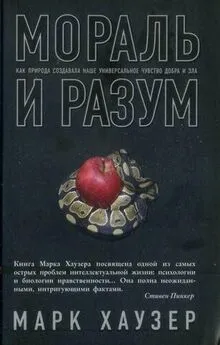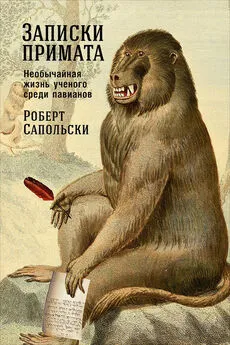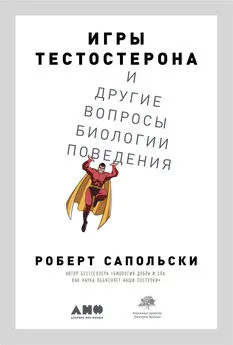Роберт Сапольски - Биология добра и зла. Как наука объясняет наши поступки
- Название:Биология добра и зла. Как наука объясняет наши поступки
- Автор:
- Жанр:
- Издательство:Альпина нон-фикшн
- Год:2019
- Город:Москва
- ISBN:978-5-0013-9051-0
- Рейтинг:
- Избранное:Добавить в избранное
-
Отзывы:
-
Ваша оценка:
Роберт Сапольски - Биология добра и зла. Как наука объясняет наши поступки краткое содержание
Биология добра и зла. Как наука объясняет наши поступки - читать онлайн бесплатно ознакомительный отрывок
Интервал:
Закладка:
J. Dovidio et al., “Commonality and the Complexity of ‘We’: Social Attitudes and Social Change,” PSPR 13 (2013): 3; E. Hehman et al., “Group Status Drives Majority and Minority Integration Preferences,” Psych Sci 23 (2011): 46.
689
Демонстрация того, что дофаминовые пути поощрения активизируются сильнее, если награда разделена с членом группы, а не с незнакомцем: J. B. Freeman and D. Fareri et al., “Social Network Modulation of Reward-Related Signals,” J Nsci 32 (2012): 9045.
690
J. Freeman et al., “The Part: Social Status Cues Shape Race Perception,” PLoS ONE 6 (2011): e25107.
691
К сноске: R. George, “Faith and Toilets,” Sci Am , November 19, 2015.
692
R. I. Dunbar and S. Shultz, “Evolution in the Social Brain,” Sci 317 (2007): 1344; R. I. Dunbar, “The Social Brain Hypothesis and Its Implications for Social Evolution,” Ann Hum Biol 36 (2009): 562; F. J. Pérez-Barbería et al. “Evidence for Coevolution of Sociality and Relative Brain Size in Three Orders of Mammals,” Evolution 61 (2007): 2811; J. Powell et al., “Orbital Prefrontal Cortex Volume Predicts Social Network Size: An Imaging Study of Individual Differences in Humans,” Proc Royal Soc B: Biol Sci 279 (2012): 2157; P. A. Lewis et al., “Ventromedial Prefrontal Volume Predicts Understanding of Others and Social Network Size,” Neuroimage 57 (2011): 1624; J. L. Powell et al., “Orbital Prefrontal Cortex Volume Correlates with Social Cognitive Competence,” Neuropsychologia 48 (2010): 3554; J. Lehmann and R. I. Dunbar, “Network Cohesion, Group Size and Neocortex Size in Female-Bonded Old World Primates,” Proc Royal Soc B: Biol Sci 276 (2009): 4417; J. Sallet et al., “Social Network Size Affects Neural Circuits in Macaques,” Sci 334 (2011): 697.
693
F. Amici et al., “Fission-Fusion Dynamics, Behavioral Flexibility, and Inhibitory Control in Primates,” Curr Biol 18 (2008): 1415; A. B. Bond et al., “Serial Reversal Learning and the Evolution of Behavioral Flexibility in Three Species of North American Corvids ( Gymnorhinus cyanocephalus, Nucifraga columbiana, Aphelocoma californica ),” JCP 121 (2007): 372; A. Bond et al., “Social Complexity and Transitive Inference in Corvids,” Animal Behav 65 (2003): 479.
694
J. Lehmann and R. I. Dunbar, “Network Cohesion, Group Size and Neocortex Size in Female-Bonded Old World Primates,” Proc Royal Soc B: Biol Sci 276 (2009): 4417.
695
J. Powell et al., “Orbital Prefrontal Cortex Volume Predicts Social Network Size: An Imaging Study of Individual Differences in Humans,” Proc Royal Soc B: Biol Sci 279 (2012): 2157; P. A. Lewis et al., “Ventromedial Prefrontal Volume Predicts Understanding of Others and Social Network Size,” Neuroimage 57 (2011): 1624; J. L. Powell et al., “Orbital Prefrontal Cortex Volume Correlates with Social Cognitive Competence,” Neuropsychologia 48 (2010): 3554; K. C. Bickart et al., “Amygdala Volume and Social Network Size in Humans,” Nat Nsci 14 (2011): 163; R. Kanai et al., “Online Social Network Size Is Reflected in Human Brain Structure,” Proc Royal Soc B: Biol Sci 279 (2012): 1327.
696
F. Elgar et al., “Income Inequality and School Bullying: Multilevel Study of Adolescents in 37 Countries,” J Adolescent Health 45 (2009): 351.
697
E. González-Bono et al., “Testosterone, Cortisol and Mood in a Sports Team Competition,” Horm Behav 35 (2009): 55; E. González-Bono et al., “Testosterone and Attribution of Successful Competition,” Aggressive Behav 26 (2000): 235.
698
N. O. Rule et al., “Perceptions of Dominance Following Glimpses of Faces and Bodies,” Perception 41 (2012): 687.
699
L. Thomsen et al., “Big and Mighty: Preverbal Infants Mentally Represent Social Dominance,” Sci 331 (2011):477.
700
S. V. Shepherd et al., “Social Status Gates Social Attention in Monkeys,” Curr Biol 16 (2006): R119; J. Massen et al., “Ravens Notice Dominance Reversals Among Conspecifics Within and Outside Their Social Group,” Nat Communications 5 (2013); 3679.
701
M. Karafin et al., “Dominance Attributions Following Damage to the Ventromedial Prefrontal Cortex,” J Cog Nsci 16 (2004): 1796; L. Mah et al., “Impairment of Social Perception Associated with Lesions of the Prefrontal Cortex,” Am J Psychiatry 161 (2004): 1247; T. Farrow et al., “Higher or Lower? The Functional Anatomy of Perceived Allocentric Social Hierarchies,” Neuroimage 57 (2011): 1552; C. F. Zink et al., “Know Your Place: Neural Processing of Social Hierarchy in Humans,” Neuron 58 (2008): 273.
702
A. A. Marsh et al., “Dominance and Submission: The Ventrolateral Prefrontal Cortex and Responses to Status Cues,” J Cog Nsci 21 (2009): 713; T. Allison et al., “Social Perception from Visual Cues: Role of the STS Region,” TICS 4 (2000): 267; J. B. Freeman et al., “Culture Shapes a Mesolimbic Response to Signals of Dominance and Subordination That Associates with Behavior,” Neuroimage 47 (2009): 353.
703
M. Nader et al., “Social Dominance in Female Monkeys: Dopamine Receptor Function and Cocaine Reinforcement,” BP 72 (2012): 414; M. P. Noonan et al., “A Neural Circuit Covarying with Social Hierarchy in Macaques,” PLoS Biol 12 (2014): e1001940; F. Wang et al., “Bidirectional Control of Social Hierarchy by Synaptic Efficacy in Medial Prefrontal Cortex,” Sci 334 (2011): 693.
704
M. Rushworth et al., “Are There Specialized Circuits for Social Cognition and Are They Unique to Humans?” PNAS 110 (2013): 10806.
705
Например: J. C. Beehner et al., “Testosterone Related to Age and Life-History Stages in Male Baboons and Geladas,” Horm Behav 56 (2009): 472.
706
J. Brady et al., “Avoidance Behavior and the Development of Duodenal Ulcers,” J the Exp Analysis of Behav 1 (1958): 69; J. Weiss, “Effects of Coping Responses on Stress,” J Comp Physiological Psych 65 (1968): 251.
707
R. Sapolsky, “The Influence of Social Hierarchy on Primate Health,” Sci 308 (2005): 648; H. Uno et al., “Hippocampal Damage Associated with Prolonged and Fatal Stress in Primates,” J Nsci 9 (1989): 1705; R. Sapolsky et al., “Hippocampal Damage Associated with Prolonged Glucocorticoid Exposure in Primates,” J Nsci 10 (1990): 2897; См. также: E. Archie et al., “Social Status Predicts Wound Healing in Wild Baboons,” PNAS 109 (2012): 9017.
708
R. Sapolsky, “The Physiology of Dominance in Stable Versus Unstable Social Hierarchies,” in Primate Social Conflict , ed. W. Mason and S. Mendoza (New York: SUNY Press, 1993).
709
L. R. Gesquiere et al., “Life at the Top: Rank and Stress in Wild Baboons,” Sci 333 (2011): 357.
710
D. Abbott et al., “Are Subordinates Always Stressed? A Comparative Analysis of Rank Differences in Cortisol Levels Among Primates,” Horm Behav 43 (2003): 67.
711
R. Sapolsky and J. Ray, “Styles of Dominance and Their Physiological Correlates Among Wild Baboons,” Am J Primat 18 (1989) 1; J. C. Ray and R. Sapolsky, “Styles of Male Social Behavior and Their Endocrine Correlates Among High-Ranking Baboons,” Am J Primat 28 (1992): 231; C. E. Virgin and R. Sapolsky, “Styles of Male Social Behavior and Their Endocrine Correlates Among Low-Ranking Baboons,” Am J Primat 42 (1997): 25.
712
J. Chiao et al., “Neural Basis of Preference for Human Social Hierarchy Versus Egalitarianism,” ANYAS 1167 (2009): 174; J. Sidanius et al., “You’re Inferior and Not Worth Our Concern: The Interface Between Empathy and Social Dominance Orientation,” J Personality 81 (2012): 313.
713
G. Sherman et al., “Leadership Is Associated with Lower Levels of Stress,” PNAS 109 (2012): 17903; R. Sapolsky, “Importance of a Sense of Control and the Physiological Benefits of Leadership,” PNAS 109 (2012): 17730.
714
N. Adler and J. Ostrove, “SES and Health: What We Know and What We Don’t,” ANYAS 896 (1999): 3; R. Wilkinson, Mind the Gap: Hierarchies, Health and Human Evolution (London: Weidenfeld and Nicolson, 2000); I. Kawachi and B. Kennedy, The Health of Nations: Why Inequality Is Harmful to Your Health (New York: New Press, 2002); M. Marmot, The Status Syndrome: How Social Standing Affects Our Health and Longevity (New York: Bloomsbury, 2015).
715
A. Todorov et al., “Inferences of Competence from Faces Predict Election Outcomes,” Sci 308 (2005): 1623.
716
T. Tsukiura and R. Cabeza, “Shared Brain Activity for Aesthetic and Moral Judgments: Implications for the Beauty-Is-Good Stereotype,” SCAN 6 (2011): 138.
717
K. Dion et al., “What Is Beautiful Is Good,” JPSP 24 (1972): 285.
718
N. K. Steffens and S. A. Haslam, “Power Through ‘Us’: Leaders’ Use of We-Referencing Language Predicts Election Victory,” PLoS ONE 8 (2013): e77952.
719
B. R. Spisak et al., “Warriors and Peacekeepers: Testing a Biosocial Implicit Leadership Hypothesis of Intergroup Relations Using Masculine and Feminine Faces,” PLoS ONE 7 (2012): e30399; B. R. Spisak, “The General Age of Leadership: Older-Looking Presidential Candidates Win Elections During War,” PLoS ONE 7 (2012): e36945; B. R. Spisak et al., “A Face for All Seasons: Searching for Context-Specific Leadership Traits and Discovering a General Preference for Perceived Health,” Front Hum Nsci 8 (2014): 792.
720
J. Antonakis and O. Dalgas, “Predicting Elections: Child’s Play!” Sci 323 (2009): 1183.
721
K. Smith et al., “linkhing Genetics and Political Attitudes: Reconceptualizing Political Ideology,” Political Psych 32 (2011): 369.
722
G. Hodson and M. Busseri, “Bright Minds and Dark Attitudes: Lower Cognitive Ability Predicts Greater Prejudice Through Right-Wing Ideology and Low Intergroup Contact,” Psych Sci 32 (2012): 187; C. Sibley and J. Duckitt, “Personality and Prejudice: A Meta-analysis and Theoretical Review,” PSPR 12 (2008): 248.
723
L. Skitka et al., “Dispositions, Ideological Scripts, or Motivated Correction? Understanding Ideological Differences in Attributions for Social Problems,” JPSP 83 (2002): 470; L. J. Skitka, “Ideological and Attributional Boundaries on Public Compassion: Reactions to Individuals and Communities Affected by a Natural Disaster,” PSPB 25 (1999): 793; L. J. Skitka and P. E. Tetlock, “Providing Public Assistance: Cognitive and Motivational Processes Underlying Liberal and Conservative Policy Preferences,” JPSP (1993): 65, 1205; G. S. Morgan et al., “When Values and Attributions Collide: Liberals’ and Conservatives’ Values Motivate Attributions for Alleged Misdeeds,” PSPB 36 (2010): 1241; J. T. Jost and M. Krochik, “Ideological Differences in Epistemic Motivation: Implications for Attitude Structure, Depth of Information Processing, Susceptibility to Persuasion, and Stereotyping,” Advances in Motivation Sci 1 (2014): 181.
Читать дальшеИнтервал:
Закладка:





![Роберт Сапольски - Игры тестостерона и другие вопросы биологии поведения [litres]](/books/1074102/robert-sapolski-igry-testosterona-i-drugie-vopros.webp)




